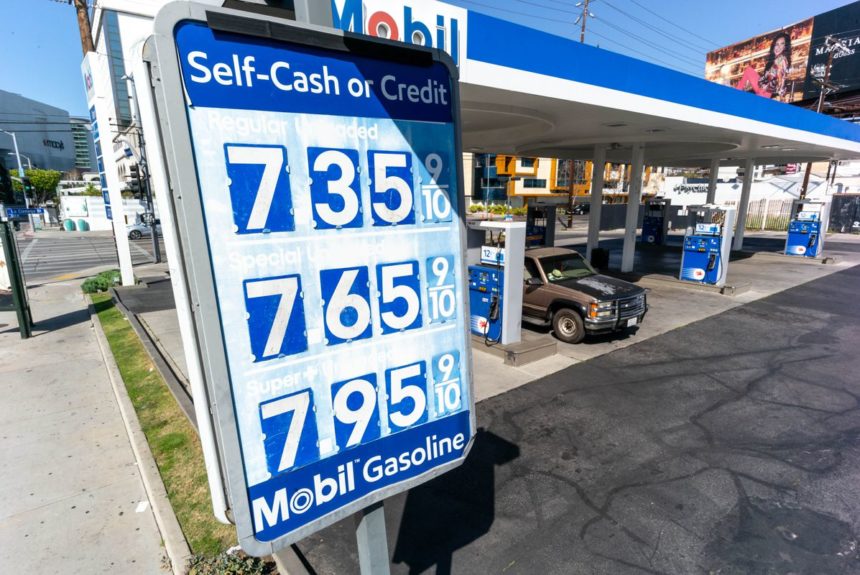Memorial Day Weekend kicked off the summer driving season, and the national average for gasoline is now up to $4.62 per gallon. Filling up a sedan can cost close to $70 while some trucks, jeeps and larger SUVS cost over $100 to fill. Low-income families have been particularly hit hard as they spend a larger percentage of their budget on gasoline and energy bills.
>>>READ: How Joe Biden can help lower gas prices and ease Americans’ pain at the pump
The economic pain extends beyond the pump as American households are paying more for groceries, going out to eat and most other goods and services as energy is an essential input for those products. Transporting goods by truck is far more expensive as the national average price for diesel is $5.52 per gallon, nearly $2.50 higher than they were a year ago.
Higher energy prices also cripple economic growth as families spend fewer dollars on other goods and services to compensate for more money spent on fuel. As Matt Yglesias points out, “ fresh research suggests that a $1 increase in gas prices generates essentially a $1 reduction in non-gas spending in the short term.”
According to a 2019 survey, 86 percent of Americans use their own car for their primary means of commuting to work. Drivers can take several steps to improve fuel efficiency. Inflating tires, reducing unnecessary weight and slowing down are small measures that will make that tank of fuel last a little longer. Some people may be able to carpool, work remotely or use public transportation, but those options aren’t available to everyone. Going out and buying an electric vehicle, as some Biden administration officials have suggested, is available to even fewer people.
Therefore, it’s not surprising that frustrated consumers are turning to Washington for solutions to the pain at the pump. But what can be done? Unfortunately, there’s no easy button for President Biden to hit as the price of gasoline set by the market is largely out of the administration’s control. The price of crude oil makes up the largest share of the price of a gallon of gasoline. From 2012-2021, the price of crude was 54.8 percent of the cost from 2011-2020. Federal and state taxes (17 percent), refining (14 percent), and distribution and marketing (14.3) made up the rest of the share. Because oil is a globally traded commodity, the price is set by factors affecting global supply and demand.
When the pandemic hit, demand cratered to a point where oil prices briefly traded at negative prices. The oil industry struggled financially, but as countries relaxed restrictions, stronger demand led to steady price increases. U.S. supply is up and will likely reach pre-pandemic levels before the end of the year; however, Russia’s invasion of Ukraine upended markets and set crude prices to triple digits.
>>>READ: A Strategy to Lower Gas Prices, Increase Energy Security
U.S. policy and regulation also affects supply and demand. While the U.S. can’t control supply disruptions in other countries or when demand increases in India, there are policy levers Congress and the administration can pull to help in the short and intermediate run.
The federal government should:
- Temporarily suspend summer blending requirements. Refiners in the U.S. shut down for a few weeks in the spring to retool their operations for a summer blend of gasoline, which reduces smog. The more expensive blend can add 5 to 15 cents per gallon. While it is a sensible regulation, Congress and the administration should consider suspending these requirements where applicable.
- Repeal the Renewable Fuel Standard (RFS) or wave refinery blending requirements. A 2019 Government Accountability Office (GAO) study found the mandate was “associated with modest gas price increases in areas outside the Midwest” for “limited effect, if any, on greenhouse gas emissions.” Other studies have projected the price impact from the ethanol mandate to be even higher. The Renewable Fuel Standard is bad economic and environmental policy and Congress should repeal it. Short of that, however, the Biden administration should wave blending requirements to shield consumers from the cost of the policy.
- Repeal or waive Jones Act requirements. The Jones Act mandates that oil (and other goods) shipped between two ports in the U.S. must be transported on a U.S.-built, U.S.-flagged vessel with a crew that is at least 75% American. Joe Petrowski, CEO of Gulf Oil, stated that “If foreign owned and flag ships were able to carry gasoline in US waters, the price of gasoline in the North East and in Florida could be 20 to 30 cents lower.”
- Approve the Keystone XL pipeline and conduct oil and gas leases sales on federal lands and waters. While not immediate, open accessing will bring more supply to the market. As we recently wrote, “Cancelling pipelines and imposing drilling bans is not going to stop oil consumption. Rather, it will increase dependence on sources with less rigorous environmental standards and from sources hostile to American interests. Any climate policy that restricts domestic production but doesn’t factor the unintended consequences of increased global emissions is a non-solution.”
- Eliminate steel and aluminum tariffs. Like many industries, the U.S. oil and gas industry is suffering from supply chain problems. Taxes on imports from American allies exacerbate these problems and drive up the cost of energy investment and infrastructure. Rather than amend these tariffs, the Biden administration should remove them entirely.
Waving or suspending these mandates and regulations won’t bring gas prices down to the $3.00 level they were a year ago. But Americans are struggling with high prices – not just at the pump but for nearly everything they buy. Every little bit of relief will help. Furthermore, opening access and strengthening America as the world’s largest oil producer will help buttress against future supply shocks.
Updated June 1, 2022. Originally published on March 15, 2022.
The views and opinions expressed are those of the author’s and do not necessarily reflect the official policy or position of C3.
